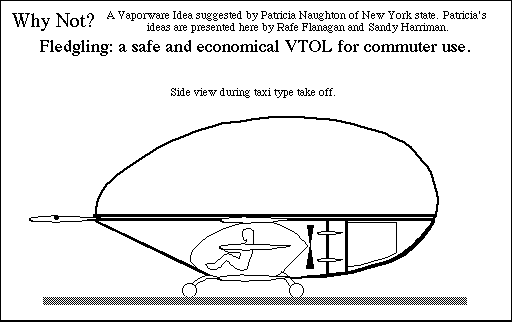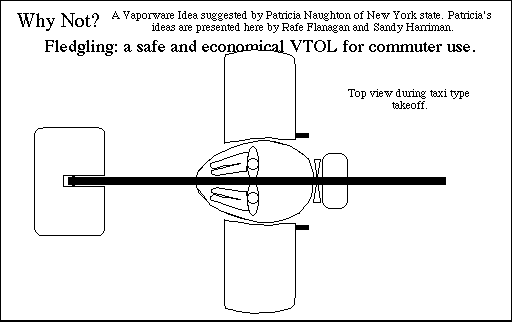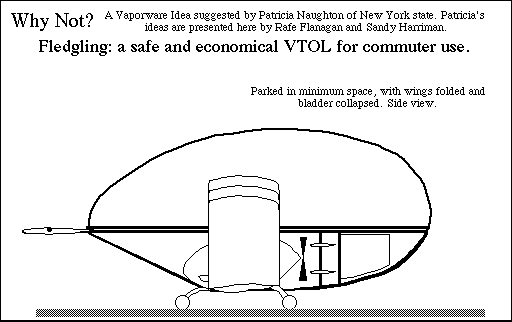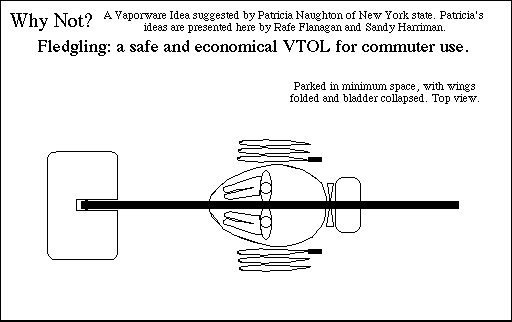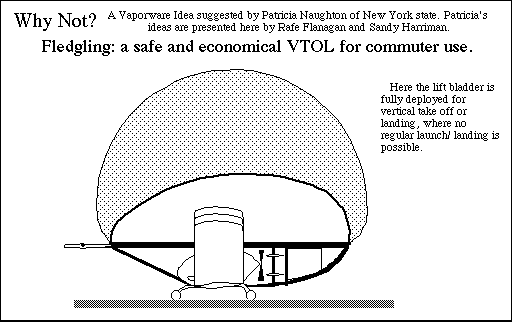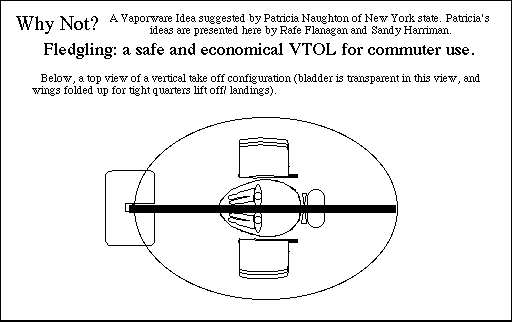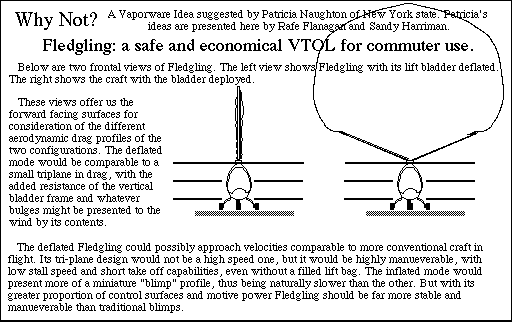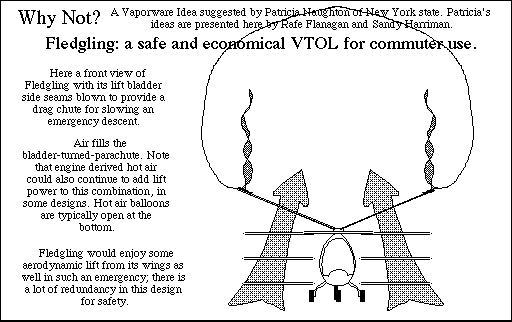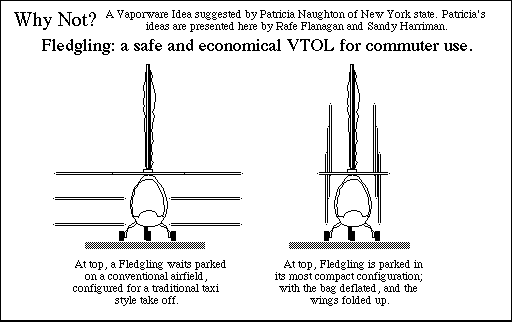






(Translate this site)
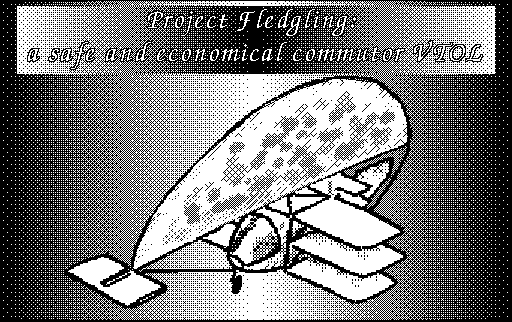
Project FledglingA possibly low cost, safe, and practical flying carSponser this pageThis page last updated on or about 6-16-06 |
Site map
       (Translate this site) |
|
Site map
|
Here we are in 1994, and still we’re riding about in automobiles not much changed from the basic design which appeared around 1894-- or a hundred years ago.
In the 1960s a popular Saturday morning cartoon was the Jetsons; a show about a family living the good life in some fabulously prosperous high tech future just over the horizon. The family car was a bubble shaped VTOL (Vertical-Takeoff-Or-Landing) aircraft capable of carrying the entire family at supersonic speeds, and yet also could be conveniently folded up into briefcase size and weight by George to save him the hassle of finding a parking place.
Though the Jetson aircar is clearly beyond our means at this time, shouldn’t there be some happy medium between the two extremes available?
Must we endure a hundred year old design for personal mobility as late as the mid nineteen-nineties? Or could we possibly realize a bit of the promise of the Jetson aircar with technologies available to us today?
The argument against the widespread availability of the power of flight
Some maintain that even if personal aircraft were to become cheaply available and easy to fly the general public should be denied access to them. The reasons? The experts say piloting would be too much for the average person-- they would either be unwilling or unable to live up to the responsibilities entailed. Beyond this, experts also claim the sudden influx of small aircraft would choke present-day air traffic control systems, becoming a source of cascading, catastrophic collisions and other accidents.
Unfortunately, given the present state of aircraft today, the critics could be right on both points.
It’s only logical that a sudden flood of civilian aircraft, all or most requiring airstrips of some kind for take offs and landings, would serve as the last straw for already overburdened airports, ushering in months if not years of horrific air traffic disasters.
Such a scenario is one of the things the FAA (Federal Aviation Administration) is supposed to prevent. But in actuality the greatest preventative so far has been the high entry threshold to flight imposed by stratospheric purchase and maintenance costs, the levels of pilot training required, and the severe restrictions on flexibility associated with conventional airplanes and helicopters.
Both airplanes and helicopters have always suffered from major failings in regards to their suitability for casual commuter use, even if the initial cost of such machines were a quarter of what they are today.
Both machines require substantial training and experience on the part of pilots. Acquired skills of a much higher level than that required for an automobile driver’s license-- as well it should be; today’s aircraft are much more complex and fraught with danger (in terms of piloting) than automobiles.
Though both types of aircraft can be difficult at times to control, helicopters are excessively so. Dangerous even with a seasoned pilot at the controls. For if helicopters lose power, they drop like a rocks from the sky. Though the most competent pilots sometimes achieve survivable landings via “auto-rotation”, the casual pilot cannot be assumed at having a good chance to do the same.
But the dangers of helicopters go further than this. The huge main rotor blades (or even the smaller rear blades) will severely injure or kill any pedestrians that unwittingly move into the wrong place at the wrong time around such a vehicle. And the small rear rotor is a source of other problems as well. If it fails, the helicopter goes into spins that often lead to crashes. If the pilot accidentally maneuvers his craft into a place where the spinning tail rotor contacts utility poles or wires, antennas, support trusses, or trees, there too you end with a crashed machine and likely fatalities.
Even if everything goes right with such a machine, you face a daunting and rigorous maintenance schedule to help keep it that way. The design of a helicopter requires that almost everything important to the craft’s core operation occur in and around the main rotor. The rotors of a helicopter are not only its ‘propellors’, but its ‘control surfaces’ as well, serving essentially the same functions for the helocopter as propellors, wings, and rudder do for planes.
So if a helocopter’s rotor begins having problems, the only comparable situation in an airplane is that its propellor, wings, and rudder are all coming apart at once!
For all the above reasons helicopters are exceedingly dangerous beasts, and not really suitable for casual civilian use.
Almost the only good thing about a helicopter is its VTOL (Vertical-Takeoff-Or-Landing) capability, which also provides the craft with its hovering functionality. Such a capacity is nearly unique in commonly available civilian craft. And has been the only saving grace of the helicopter since its invention. If not for its VTOL virtues, such a hellish device would never have been produced in large numbers.
As you might conclude from the above, the present forms of aircraft available only enforce the logic that most of us are better off without a flying vehicle in our possession. Those at hand are simply too dangerous, costly, and difficult to pilot to be as useful to us in daily life as our automobiles.
In light of this, we may safely assume that an entirely new form of aircraft would be needed to make the power of flight truly accessible to the majority of us in any practical, useful manner. A new form of craft that would be sufficiently easy to fly and maintain as to require little more skill than driving an automobile, and low enough in price to compete with cars in functionality.
Traffic considerations
One traffic side of the argument against widely available flight capabilities consists of the notion that collisions are more probable and harder to avoid in aviation than automobile traffic.
Even with the burden of the costly, dangerous, and limited craft we presently must endure, this argument is specious for the vast majority of airspace, really being only applicable to the small area around airports-- and even there being almost entirely untrue given one important condition of such traffic, which might be realized sooner rather than later.
Airspace is fundamentally different from roadspace in some important ways: for one thing, there’s a whole extra dimension to airspace compared to roadspace (roadspace is basically two dimensional, airspace three). If we assumed roadspace had no restrictions on it whatsoever in its two dimensional domain (i.e., you could drive your car through yards, buildings, and wilderness as desired), then roadspace would be just as safe as a single layer of airspace, of sufficient altitude to clear trees, mountaintops, and skyscrapers.
But roadspace is not free of two dimensional restrictions; in the vast majority of cases we are severely restricted in where we may pilot our automobiles in roadspace. Right off the bat we lose 70% of the surface area of the planet, since it’s comprised of water-- we can’t drive on the high seas. Then there’s the vast untracked wilderness areas of the remaining 30% of the surface-- the land masses. The lion’s share of present day automobiles cannot go where there are no roads-- and even the best four wheel drives are easily stopped by natural obstacles such as swamps, rivers, and chasms. Finally, we come to the boundaries of civilization-- cities and the roads connecting them. Here at last automobiles are in their element, free of restrictions, right? Wrong. Even here, among the interstate cloverleafs and urban and suburban sprawl that form humanity’s worldwide monument to the automobile, most roadspace is tightly confined either to the narrow lanes of a checkerboard pattern between city blocks, or hundreds of miles of lonely two way ribbons stretching between metropolitan centers.
With millions and millions of wheeled vehicles largely confined to these checkerboards and connecting ribbons, is it any wonder we suffer so many accidents? For we have little choice in many instances but to plow straight ahead into the vehicle or obstacle destined to serve as our counterpart in an accident.
What’s worse, the computerized guidance systems that might prevent such mayhem are confounded by the complexities of the roundabout and convoluted manner roadspace must be navigated in order to get from point A to point B. Often times even the most intelligent among us are stymied by the perverse elements involved-- so how might we expect a machine to figure it out?
And yet computers may comparatively easily and routinely navigate the skies/ airspace above. For in airspace travel from point A to point B is often a straight line, or else suffers from only a trifling few departures from that ideal. In airspace there is no highway construction to detour around, no significant manipulation of important landmarks by locals to confuse the traveler, no residue of recent natural events like landslides, floods, and earthquakes to bar our way with fallen bridges, washed out highways, and tons of misplaced earth.
But perhaps best of all, there’s no checkerboard restrictions-- you may pretty much travel a straight line in any direction that will minimize your travel time in airspace. Even better, if you find the present layer of transportation to present any problem to your plans, you can simply move to a fresh one-- in airspace there’s always a fresh travel layer just a change in altitude away-- unlike roadspace, which confines drivers to a single layer, and oftentimes not even one alternative route to the desired destination.

There are many developments in aviation which will only make airspace travel safer as time goes on. The FAA is directing advances in new anti-collision equipment to be installed in all flying craft. Satellite navigational systems are coming on-line that may pinpoint anyone’s location in seconds (And also help coordinate vehicle courses to avoid collisions). Computer technologies are becoming smarter and capable of doing more and more of the work required in all aspects of aviation concerns. The ‘automatic pilot’ on today’s commercial airliners will eventually replace human ones, for it will become better than a person can possibly be in such a job. True, it will probably be fifty more years before we become willing to put large numbers of passenger lives exclusively in silicon hands for commercial flights. But the case may well be different for smaller commuter craft. Convenience and safety will soon demand it, practicality support it, and technology spawned changes make it more desirable with each passing day.
We already install cruise control on automobiles to relieve ourselves of throttle duty on long trips. If we didn’t have to worry about steering, braking, and related matters, we’d delegate those functions to hardware too; but the highways an auto faces are far more dangerous than the airways are for aircraft. Perhaps as much as 95% of flight time could be spent by airplanes veering off course by hundreds of miles without much more worry than that of a reduced fuel supply or greater delay in reaching a planned destination. But an automobile can usually go off course by only a few inches before incurring danger of catastrophic collision, or loss of a hard surface to travel, becoming trapped in quagmires of various sorts.
The safe tolerance for navigational error is far greater for an aircraft above ground clearance altitude than for any automobile in roadspace.
Like the commercial airliners, a civilian commuter aircraft would face its greatest dangers during take offs and landings. The cruise inbetween might become auto pilot territory immediately after the novelty of manually piloting the craft wore off its owner. And if the private craft possessed VTOL capabilities, used for landing precisely in one’s driveway, backyard, or reinforced roof deck, and its landing was no more dramatic than a simple and slow descent, straight down to mate as closely as possible with your own radio beacon, even take offs and landings might quickly be usurped by computer. For these operations simply would not be anything like the difficult and frightening task that faces commercial airline pilots who must navigate a huge craft onto a relatively narrow air strip at hundreds of miles an hour, and immediately screech to a stop before they run out of tarmac.
The critics of mass consumer aviation, when confronted with the above facts, will next fall back on the more substantive core of their congestion argument-- that the level of air traffic around airports would become quickly intolerable in the event that many people suddenly gained the power of flight. They paint gruesome pictures of widespread catastrophe at airports everywhere, as tiny civilian aircraft fly like flocks of birds into the jet intakes of large commercial liners, causing death and carnage on a massive scale.
If you’re laughing at the above scenario, you’re in the minority-- most people seem to take this prospect seriously when it is presented on news and talk shows.
Just what would happen if suddenly most people possessed their own aircraft? Particularly in regards to major airport air traffic?
Well, if the majority of folks who obtained an aircraft got one with VTOL capabilities that they could land and garage at their own homes, why in the world would they frequent a major airport twenty to a hundred miles out of their way?
So the suicidal masses of flyers sweeping into jet intakes probably wouldn’t be coming from this crowd.
And as we pointed out before, any craft not equipped with full VTOL capability would not likely be bought in large numbers anyway, as its utility would not be significantly superior to older means of aero-transport.
There’s also this to consider: wouldn’t quite a few of the folks who bought VTOLs do so only because their work or lifestyle required a lot of flying? Wouldn’t it be safe to assume that lots of VTOL buyers were frequent flyers on commercial airliners prior to buying their VTOLs?
Would it make sense for these people to continue flying on commercial airliners when it’d often be simpler, cheaper, and more convenient for them to take their own VTOL instead?
Wow! It looks like not only would VTOL owners usually want to go nowhere near a major airport during flights, but in the act of purchasing their own craft they’d also be cutting down significantly the number of passengers flying the commercial airliners!
In this scenario the feared fleets of personal aircraft endangering the airports disappear-- and even the number of commercial airliner flights seems reduced as well, turning the major airports into something more like ghost towns than hectic thoroughfares.
Far from becoming a scene of mass carnage and confusion, the big airports look more likely to become nearly deserted as a result of widely available VTOL commuter craft.

However, we must remember that this safe and happy traffic environment is heavily dependent on the assumption that VTOL craft become the primary vehicle used by civilian flyers-- but such a craft is not readily available today. Helicopters can by no means be regarded as fulfilling this role, for the reasons listed before.
But just because there is no suitable VTOL available today doesn’t mean there won’t be one tomorrow. Let us examine one type of vehicle that might make safe and economical VTOL capability available to nearly everyone.
Project code name “Fledgling”(relating to the definition of a young bird, just able to fly on its own);
A general description
Fledgling is a proposal for a cheap, safe VTOL (Vertical-Takeoff-Or-Landing) for commuter use. Fledgling would be constructed from typical ultralight materials, so that total vehicle weight would be minimal. It would seat two average adults in a pinch, but not comfortably-- that capability would be up to later generations of the craft to accomplish. Also, the design of Fledgling in this proposal assumes full VTOL capability with only one adult and possibly a few groceries onboard-- anything more might require STOL taxiing on runways of some sort.
Fledgling is a hybrid aircraft, utilizing both aerostatic and aerodynamic lift to fuse true VTOL capability with conventional airplane flight cheaply and safely. Fledgling's wings would fold up 60 degrees or more in parking configuration to minimize the footprint of the craft, making it more suitable for the automobile size driveways and parking spots that already exist everywhere.
The aerostatic bag would be stored and deployed as needed from above the craft. The bag would have three rigid members shaping it and binding it to the craft. These members would also serve as the frame of the storage structure when the bag was not in deployment. The bag will be like a huge but lightweight version of a lady's change purse, with the difference that when the top splits open, a balloon will expand out of it. The sides of the purse will actually be the sides of the balloon, or lifting bladder. The balloon could be filled and maintained primarily by the hot exhaust of the engine for rapid deployment, and through reversing ductwork, be sucked back into place by engine power as well, when no longer required by the pilot. The extra material of the balloon's top will thus be often trapped within the closed sides of the purse-like storage structure. Though this bulked up material will make the top storage structure unlikely to be entirely smooth in flight, its air resistance load should still be manageable by the Fledgling. Fast, smooth deployment and retrieval of the balloon volume should be no problem with suitable duct control of the engine's exhaust and intake ports (along with a relief valve to prevent engine stalling). The suction generated on retrieval should draw in and pack the balloon material in a size-reducing and perhaps elegant manner, inside its purse-like container. Transition from an aerostatic take off to aerodynamic flight would be simple. Pilots would usually rise to a safe height, lower and lock the wings (if they were rising from a narrow driveway), nudge forward under power, gradually building lift under the wings, and slowly deflating and retreiving the balloon as they did so.
For vertical landings, the routine would just be the reverse of this: slowing one's forward motion as the filling balloon above took up more and more of your craft's weight. Then, at maximum aerostatic lift, you redirect your engine thrust up or down to control your descent as desired, via control surfaces. If desired for tight parking, you might also fold your wings up at this point.
Fledgling would also be capable of rolling take offs and landings, with the balloon completely deflated and stored away. In these cases Fledgling’s ultralight weight and considerable wing area should easily make the craft a STOL (Short-TakeOff-Or-Landing) aircraft.
Safety and redundancy
Fledgling could be one of the safest craft ever flown. The most dangerous aspect of it may well be the temptation by its pilots to exploit its capabilities to the limit.
Several elements should help minimize safety problems.
One would be the gliding capability provided by the plethora of wing surfaces. Even if a couple of wings were damaged or lost, there would still be several more remaining. And if the bag were intact, that lift too would still be there.
Strategically placed, manually activated bursting seams could convert the roof of the deployed balloon into a fair size parachute in an emergency, thus slowing a descent in that fashion, if all else failed.
Payload carrying flexibility
Fledgling's limited power and cargo-carrying capacity could be extended a bit by the vehicle's innate flexibility. It's VTOL capacity, for example, could be given up for taxiing take offs where runway permitted and payload weight demanded.
In other situations, the pilot might elect to maintain inflation with the lift bladder even once airborne and underway, to help save fuel for a slow moving, fairly heavy cargo run.
Fledgling would possess more total lifting capacity than might be apparent in its appearance. The primary wings themselves, though short, are tripled on each side to make the craft a tri-plane. So lift is maximized there even as the total footprint of the craft on the tarmac is kept to a minimum. The Fledgling's large front canard wing would add to the total lift available. The smaller ducting foil behind the propeller also contributes. And then there's the aerostatic lift element.
The bag would be roughly spherical in shape when fully deployed, and require an average radius of at least sixteen feet, to provide about 400 lbs of lift by way of 17,157 cubic feet in volume. This minimal lift would allow for only the lightest weight of airframe, engine, and other components. To gain additional aerostatic lift, you could increase the size of the lifting bladder in the design, or further lighten total vehicle weight. However, beyond a certain point in such a scaling up the bladder may become so large that Fledgling would no longer be able to use it in STOL maneuvers, and the craft could quite possibly become top heavy when the balloon was stowed away.
To summarize and expand a bit upon Fledgling’s capabilities, let us list altogether its various modes of landings and take offs, and outright flight:
Fledgling take off and landing options:
1. Conventional plane taxi style take off and landing, requiring a run way, for fast commuter hops between two locales possessing short airstrips or little used lengths of straight roadway. This mode might be used often, by virtue of its fast initiation and termination of flights, and potential for conveniently increasing payload without deployment of the lifting bladder.
2. A mix of both taxiing and vertical lift for short take-off or landing (STOL) and/or maximum payload capabilities (the lift bladder deployed).
3. Pure vertical take offs and landings, where the wings play little or no role in initial ascent or final descent. This mode would be desirable on trips to very precise or crowded locations, such as the grocery store, mall, or gas station, as well as for returning to one’s own driveway. This mode would be the most limited in terms of payload size, and perhaps most time consuming in actual launch and landing procedures. Yet it would be the element of Fledgling capabilities which made the craft most like a flying version of an automobile, able to move its owner from point A to point B with maximum convenience and freedom.
Fledgling flight alternatives:
1. Conventional airplane style, with the bag deflated, for maximum cruise velocity. Maximum cruising speed for the craft described here would likely be between 80 and 125 miles per hour.

2. A mix of aerodynamic and aerostatic lift, for extra cargo carrying capacity, utilizing Fledgling’s short take off and landing capability, with the lifting bladder deployed throughout all stages of transport. With the bladder deployed, cruising speed would likely be greatly diminished, perhaps to as low as 30 to 50 miles per hour, depending on the size of the payload and available engine power.
If tests showed Fledgling required more power or engine efficiency in order to operate as theorized here, a light duty jet engine might be substituted for the propellor system. This substitution might also be done simply to improve the craft’s performance beyond the adequate, as the jet might allow faster transition times between vertical take offs/ landings and full blown airplane mode. The addition of jet thrust might also speed vertical ascents and descents, allow greater cruising speed, and greater payload capacity, as well as more flexibility in vectoring thrust flow.
On the following pages are presented artist's renderings of the basic configuration of the Fledgling. They are conceptual drawings only, with no dimensions provided and only a loose sense of the proportions such a craft might have.
